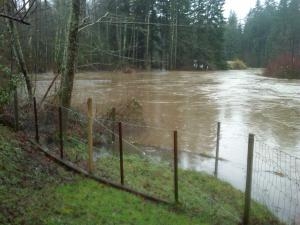Comox Valley Local Governments Showcase A Regional Response to Infrastructure Liability on June 30, 2011
The initial capital cost of municipal infrastructure is about 20% of the life-cycle cost; the other 80% largely represents a future unfunded liability. Each year, the funding shortfall grows. Fiscal constraints provide a driver for a change in the way local governments plan, finance, implement and over time replace infrastructure.
Through a program of professional development, the four Comox Valley local governments are striving for a consistent regional approach to Sustainable Service Delivery. The focus of the 2011 Seminar Series is on how all those involved in land development have a role to play.
In April, Seminar #1 painted a picture of the ‘legacy liability’ of existing hard infrastructure – that is: roads and pipes.
In May, Seminar #2 dealt with green infrastructure and ‘sustainable urban drainage’.
On June 30, Seminar #3 will focus on floodplain and flooding issues.
Risk Management Theme – “Respect the Power of Nature”
 The focus of Session #3 will be on floodplain and flooding issues, with emphasis on a ‘risk management’ approach to sea level rise and climate change adaptation:
The focus of Session #3 will be on floodplain and flooding issues, with emphasis on a ‘risk management’ approach to sea level rise and climate change adaptation:
- Because we have a limited ability to engineer change, we need to be cautious and anticipate nature’s extremes.
A desired outcome is that participants will understand how a common-sense approach to determining ‘risk tolerance’ would inform the Comox Valley regional response to climate change and infrastructure liability.
Agenda Overview
 “The day is divided into two parts, with the sub-theme unifying the two parts being alignment of efforts at a watershed scale. First, we focus on establishing expectations – this is what we want our valley to look like! Then the spotlight shifts to delivering on expectations – this is how we can and will get there,” reports Glenn Westendorp, Public Works Superintendent with the Town of Comox. He is Chair of the 2011 Seminar Series.
“The day is divided into two parts, with the sub-theme unifying the two parts being alignment of efforts at a watershed scale. First, we focus on establishing expectations – this is what we want our valley to look like! Then the spotlight shifts to delivering on expectations – this is how we can and will get there,” reports Glenn Westendorp, Public Works Superintendent with the Town of Comox. He is Chair of the 2011 Seminar Series.
“In the morning, Kate Miller of the Cowichan Valley Regional  District is our special guest. Showcasing of the Lower Cowichan River integrated plan for flood management creates an opportunity for inter-valley sharing because we in the Comox Valley can learn from the recent experience of our peers in the Cowichan Valley.”
District is our special guest. Showcasing of the Lower Cowichan River integrated plan for flood management creates an opportunity for inter-valley sharing because we in the Comox Valley can learn from the recent experience of our peers in the Cowichan Valley.”
“In the afternoon, the Tsolum River case study provides the segue to the bigger picture – that is, a watershed-based approach to land use and conservation. The watershed-based approach takes a long-term and holistic view, gets it right at the beginning, and is then proactive in anticipating and managing change.”
Town-Hall Sharing Segment
“The Tsolum River case study will be a panel conversation involving all members of the Comox Valley Regional Team. It will transition into a town-hall sharing segment where we will foreshadow what  will be in the Joint Report on A Regional Response to Infrastructure Liability,” continues Derek Richmond, Manager of Engineering with the City of Courtenay.
will be in the Joint Report on A Regional Response to Infrastructure Liability,” continues Derek Richmond, Manager of Engineering with the City of Courtenay.
“The objectives for the town-hall segment are two-fold: 1) reflect on what participants have learned at the three seminars in the series; and, 2) brainstorm how the regional team and participants from other organizations can build on the understanding gained from the 2011 Series,” summarizes Derek Richmond.
“In short, we will weave together the series outcomes and how they will be reflected in the Joint Report,” concludes Glenn Westendorp.
Agenda:
For more information about the seminar content, click on Agenda for Seminar #3 on June 30. The scope of the 2011 Series is encapsulated in the image below. To download a PDF copy, click on the 2011 program at a glance.
Posted June 2011


